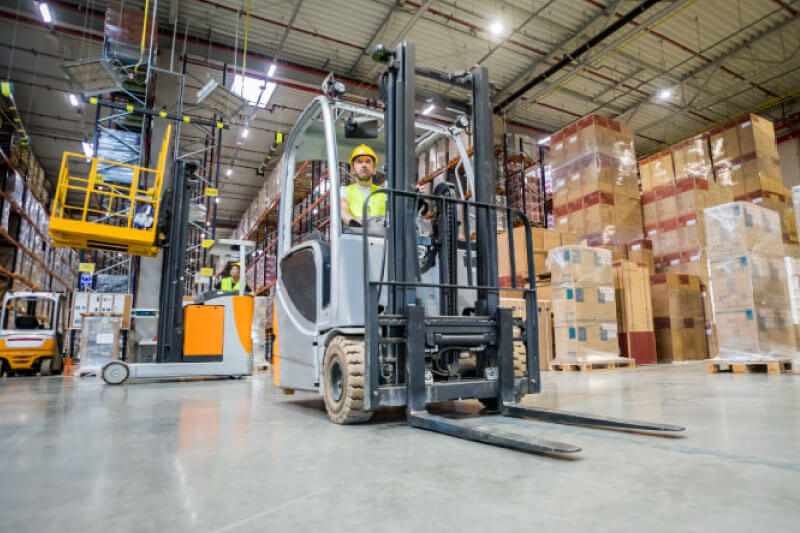Contents
Powered industrial trucks, commonly known as forklifts, are essential pieces of equipment in many businesses, but they can also be dangerous. According to the Occupational Safety and Health Administration (OSHA), there are approximately 85 forklift fatalities and 34,900 injuries recorded each year in the United States. These accidents could have been avoided if proper forklift driver safety measures were observed and monitoring technologies were implemented.
As a business owner, it’s important to make sure your employees are following safety protocol. This is especially true for powered industrial truck operators, as their job comes with a unique set of dangers.
In this blog post, we’ll go over some ways to improve forklift driver safety. By following these forklift safety tips, you can help create a better work environment for your employees and avoid potential accidents.
Ways To Improve Your Forklift Driver’s Safety
Ensure that all operators are properly trained and certified
OSHA requires that all operators receive forklift training on how to safely operate the equipment. This training should be provided by a qualified instructor and should cover topics such as safe driving techniques, load capacity, and stability. Operators should also be certified as proficient in operating the particular type of forklift that they will be using.
Inspect forklifts regularly
Forklifts should be inspected daily before use to ensure that they are in good working order. Forklift maintenance includes checking the parking brake, lights, tires, and hydraulic fluid levels. Any defects should be repaired before the forklift is used. In addition, forklifts should undergo a more thorough inspection at least once a month by a qualified technician.
Put up proper signages
While safe driving practices and proper training should be enforced, the company should also do its part by putting up signages, especially in high-risk zones. You can mark physical hazards, put up speed limit signs, display overhead guard warnings, and install other appropriate signaling devices throughout the warehouse to warn people of potential hazards.

Forklift drivers should always wear a seatbelt
This may seem like an obvious one and always a part of safety training programs, but you’d be surprised how many forklift operators don’t wear seatbelts while driving. Seatbelts are one of the best ways to greatly increase forklift driver safety in the workplace.
Wearing a seatbelt helps keep the operator secure in the event of a collision or tip-over. A seatbelt will keep the driver in their seat in case of a sudden stop or collision, and can potentially save their life from a serious injury, or worse, fatal forklift accidents. Make sure your drivers are buckling up before they start operating the forklift.
Drivers should be aware of their surroundings
Forklifts are large and can cause serious damage if they hit someone or something. That’s why it’s important for drivers to be aware of their surroundings at all times and look out for people and obstacles. If they see someone or something in their path, they should slow down and proceed with caution.
Laser-like focus is essential, especially in busy warehouses where there is a lot of activity. It’s easy to get distracted, but it’s important to stay focused on the task at hand.
Operate the forklift at the correct speed
Too fast or too slow can be dangerous: Driving the forklift too fast can increase the risk of an accident while driving too slow can impede productivity. Drivers should operate the forklift at a speed that is safe and efficient.
Make sure the forks are lowered to the ground before driving forward
This is another safety precaution that is often overlooked. If the forks are not lowered to the ground before driving to loading docks, there is a risk of them becoming caught on something and causing the load to tip over. Drivers should always lower the forks to the ground before driving forward to avoid this potential hazard.
Be aware of the weight of the load
It’s important for drivers to be aware of how much weight they are carrying at all times. If a load is too heavy, it can cause the forklift to tip over. Drivers should only carry loads that they feel comfortable lifting without putting themselves or others in danger. Additionally, how much weight the forklift as specified by the manufacturer can safely carry should be checked with the manufacturer’s specifications.
Use caution when turning
It’s easy to lose control of a forklift when turning if drivers are not careful. This is especially true if the forklift is carrying a heavy load. When turning, operators should take things slowly and use caution so that they don’t lose control of the forklift and cause accidents or injuries.
Never operate a forklift when tired or drunk
This forklift driver safety tip goes without saying. Operating any kind of machinery while under the influence of alcohol is extremely dangerous. Make sure your drivers know this rule and follow it at all times.
Driving a forklift for long periods of time can also be tiring. That’s why it’s important for operators to take regular breaks so that they can avoid fatigue. Breaks will also help them stay alert and focused while operating the forklift.
Install additional safety features
There are several different safety features that can be installed on the vehicle to improve forklift driver safety. Some of these features include seat belts, forks with guardrails, backup alarms, and cameras. Seat belts help keep the operator securely in the seat in case of a sudden stop or collision. Forks with guardrails help prevent loads from shifting during transport. Backup alarms warn nearby workers when the forklift is backing up. Cameras give the operator a better view of their surroundings, which can help them avoid accidents.
Use Litum UWB RTLS for Forklift Safety
Litum’s Forklift Collision Warning System uses ultra-wideband (UWB) active RTLS technology to track forklifts and other lifting equipment. The signals from each forklift tag are converted into location data using algorithms such as time difference of arrival, time of flight, and trilateration.
The Forklift Collision Warning System can be integrated with other safety features such as speed limiters and stop buttons. Here are some of the features you can benefit from our solution:
Forklift Proximity Warning System
One way to improve workplace safety is to invest in a forklift proximity warning system. These systems use sensors to detect people or other forklifts in the vicinity and alert the operator with audiovisual alerts. This gives the operator time to slow down or stop completely, avoiding a collision.
Autonomous Speed Control
Another way to improve safety is to implement autonomous speed control. This means that the forklift’s speed will be automatically controlled when it gets too close to other lifting equipment or people. This ensures that operators always maintain a safe distance from potential hazards.
Track Forklifts with RTLS Asset Tracking
Finally, another way to improve safety is to asset tracking with an RTLS forklift tracking. This system uses sensors to locate assets with the highest accuracy, no matter how big the area is. This is valuable for two reasons: first, it allows you to see where all your forklifts are at all times, and second, it can help you find a lost or stolen forklift quickly.
Keeping Your Forklift Operator Safe
Integrating the forklift collision warning system with other safety features can help create a safer work environment for operators and other workers. By preventing collisions and reducing the speed of forklifts, the risk of injuries and damage to property is reduced. Implementing these forklift safety procedures can help create a safer workplace for everyone.
The most convenient and effective way to enhance forklift driver safety is to automate it with the help of Litum. Contact us today so we can discuss how we can help in ensuring the safety of your warehouse operations.






